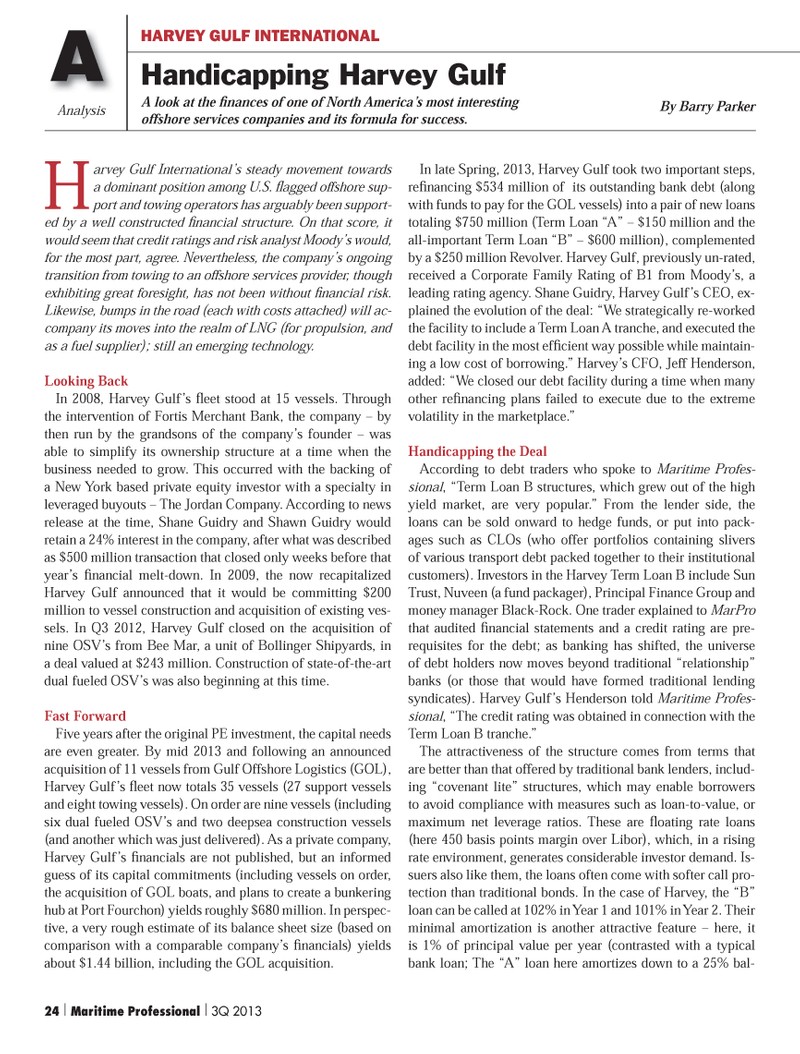
Page 24: of Maritime Logistics Professional Magazine (Q3 2013)
Training & Security
Read this page in Pdf, Flash or Html5 edition of Q3 2013 Maritime Logistics Professional Magazine
Harvey Gulf International?s steady movement towards a dominant position among U.S. agged offshore sup- port and towing operators has arguably been support- ed by a well constructed nancial structure. On that score, it would seem that credit ratings and risk analyst Moody?s would, for the most part, agree. Nevertheless, the company?s ongoing transition from towing to an offshore services provider, though exhibiting great foresight, has not been without nancial risk. Likewise, bumps in the road (each with costs attached) will ac- company its moves into the realm of LNG (for propulsion, and as a fuel supplier); still an emerging technology. Looking BackIn 2008, Harvey Gulf?s eet stood at 15 vessels. Through the intervention of Fortis Merchant Bank, the company ? by then run by the grandsons of the company?s founder ? was able to simplify its ownership structure at a time when the business needed to grow. This occurred with the backing of a New York based private equity investor with a specialty in leveraged buyouts ? The Jordan Company. According to news release at the time, Shane Guidry and Shawn Guidry would retain a 24% interest in the company, after what was described as $500 million transaction that closed only weeks before that year?s nancial melt-down. In 2009, the now recapitalized Harvey Gulf announced that it would be committing $200 million to vessel construction and acquisition of existing ves- sels. In Q3 2012, Harvey Gulf closed on the acquisition of nine OSV?s from Bee Mar, a unit of Bollinger Shipyards, in a deal valued at $243 million. Construction of state-of-the-art dual fueled OSV?s was also beginning at this time. Fast Forward Five years after the original PE investment, the capital needs are even greater. By mid 2013 and following an announced acquisition of 11 vessels from Gulf Offshore Logistics (GOL), Harvey Gulf?s eet now totals 35 vessels (27 support vessels and eight towing vessels). On order are nine vessels (including six dual fueled OSV?s and two deepsea construction vessels (and another which was just delivered). As a private company, Harvey Gulf?s nancials are not published, but an informed guess of its capital commitments (including vessels on order, the acquisition of GOL boats, and plans to create a bunkering hub at Port Fourchon) yields roughly $680 million. In perspec- tive, a very rough estimate of its balance sheet size (based on comparison with a comparable company?s nancials) yields about $1.44 billion, including the GOL acquisition. In late Spring, 2013, Harvey Gulf took two important steps, re nancing $534 million of its outstanding bank debt (along with funds to pay for the GOL vessels) into a pair of new loans totaling $750 million (Term Loan ?A? ? $150 million and the all-important Term Loan ?B? ? $600 million), complemented by a $250 million Revolver. Harvey Gulf, previously un-rated, received a Corporate Family Rating of B1 from Moody?s, a leading rating agency. Shane Guidry, Harvey Gulf?s CEO, ex- plained the evolution of the deal: ?We strategically re-worked the facility to include a Term Loan A tranche, and executed the debt facility in the most ef cient way possible while maintain- ing a low cost of borrowing.? Harvey?s CFO, Jeff Henderson, added: ?We closed our debt facility during a time when many other re nancing plans failed to execute due to the extreme volatility in the marketplace.? Handicapping the DealAccording to debt traders who spoke to Maritime Profes-sional, ?Term Loan B structures, which grew out of the high yield market, are very popular.? From the lender side, the loans can be sold onward to hedge funds, or put into pack- ages such as CLOs (who offer portfolios containing slivers of various transport debt packed together to their institutional customers). Investors in the Harvey Term Loan B include Sun Trust, Nuveen (a fund packager), Principal Finance Group and money manager Black-Rock. One trader explained to MarPro that audited nancial statements and a credit rating are pre- requisites for the debt; as banking has shifted, the universe of debt holders now moves beyond traditional ?relationship? banks (or those that would have formed traditional lending syndicates). Harvey Gulf?s Henderson told Maritime Profes- sional, ?The credit rating was obtained in connection with the Term Loan B tranche.? The attractiveness of the structure comes from terms that are better than that offered by traditional bank lenders, includ- ing ?covenant lite? structures, which may enable borrowers to avoid compliance with measures such as loan-to-value, or maximum net leverage ratios. These are oating rate loans (here 450 basis points margin over Libor), which, in a rising rate environment, generates considerable investor demand. Is- suers also like them, the loans often come with softer call pro- tection than traditional bonds. In the case of Harvey, the ?B? loan can be called at 102% in Year 1 and 101% in Year 2. Their minimal amortization is another attractive feature ? here, it is 1% of principal value per year (contrasted with a typical bank loan; The ?A? loan here amortizes down to a 25% bal- AnalysisHARVEY GULF INTERNATIONAL Handicapping Harvey GulfABy Barry Parker A look at the Þ nances of one of North AmericaÕs most interesting offshore services companies and its formula for success. 24 | Maritime Professional | 3Q 2013MP #3 18-33.indd 24MP #3 18-33.indd 249/10/2013 10:09:42 AM9/10/2013 10:09:42 AM

 23
23

 25
25
